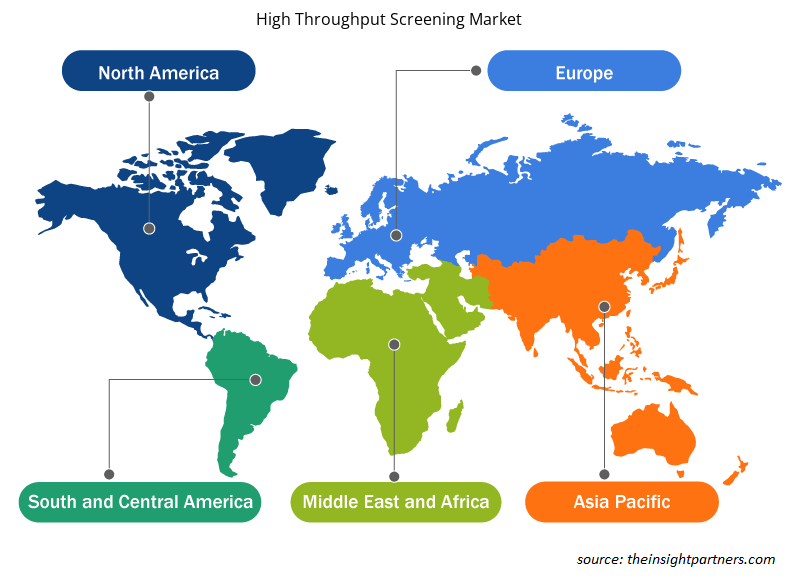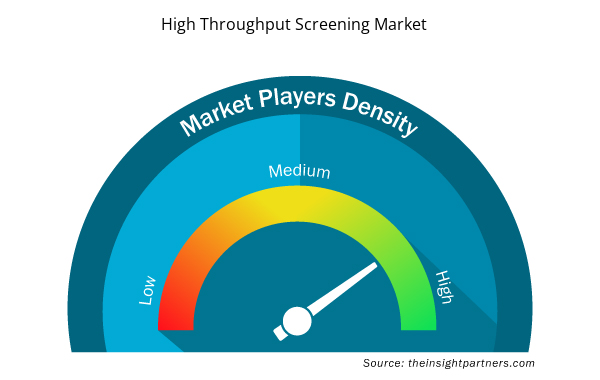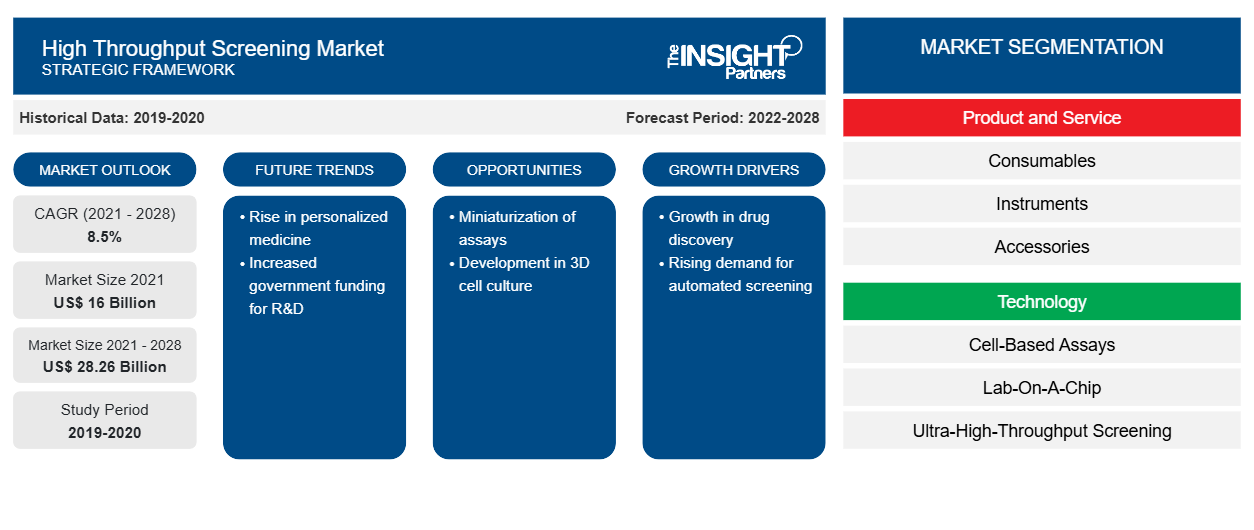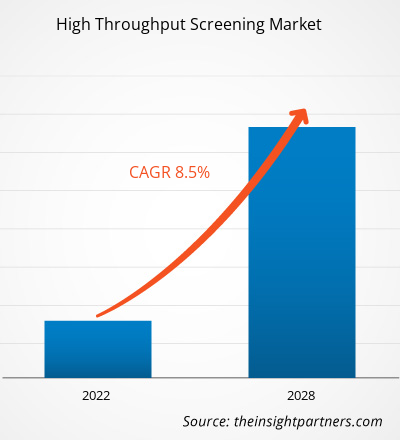Le marché du criblage à haut débit devrait atteindre 28 255,71 millions USD d'ici 2028, contre 15 997,47 millions USD en 2021. Le marché devrait croître à un TCAC de 8,5 % de 2021 à 2028.
Le criblage à haut débit (HTS) est une méthode de découverte de médicaments qui permet de tester automatiquement divers composés chimiques ou biologiques pour une cible biologique spécifique. Les méthodes de criblage à haut débit sont largement utilisées dans l'industrie pharmaceutique, exploitant la robotique et l'automatisation pour tester rapidement l'activité biologique ou biochimique d'un nombre important de molécules, généralement des médicaments. Elles accélèrent l'analyse des cibles, car des bibliothèques de composés à grande échelle peuvent bientôt être criblées de manière rentable. Le HTS est un outil précieux pour évaluer les cibles pharmacologiques, profiler pharmacologiquement les agonistes et les antagonistes des récepteurs (tels que les GPCR ) et des enzymes. Des facteurs tels qu'une augmentation des investissements dans la recherche et le développement par l'industrie pharmaceutique et biotechnologique et l'introduction de produits technologiquement avancés sur le marché du criblage à haut débit devraient stimuler la croissance du marché au fil des ans. Cependant, le coût élevé du criblage à haut débit, le manque de professionnels qualifiés et la complexité du développement des tests sont susceptibles d'entraver la croissance du marché dans les années à venir.
Informations sur le marché
Augmentation des investissements dans la recherche et le développement de l'industrie pharmaceutique et biotechnologique
L’augmentation des dépenses de recherche et développement des sociétés pharmaceutiques et biotechnologiques et l’arrivée de nouveaux médicaments pour traiter diverses maladies chroniques telles que les troubles cardiovasculaires, le cancer, les troubles immunologiques, les troubles métaboliques et les troubles neurologiques sont des facteurs importants de croissance du marché du criblage à haut débit. Plusieurs grandes et petites sociétés pharmaceutiques participent au développement et à la fabrication de nouvelles molécules pour plusieurs maladies potentiellement mortelles. Cela a conduit au choix de méthodes de criblage à haut débit automatisées (HTS) pour cribler d’énormes bibliothèques chimiques afin de répondre aux besoins de molécules cibles de médicaments en constante augmentation. Par exemple, un système de criblage à haut débit automatisé peut cribler environ 10 000 à 100 000 composés cibles en une seule journée. Les sociétés pharmaceutiques et biotechnologiques ont considérablement investi dans les techniques de criblage à haut débit au cours de la dernière décennie. Par exemple, la célèbre alliance de Millennium Pharmaceuticals, Inc. et de Bayer AG a découvert avec succès 18 nouvelles cibles médicamenteuses et en a amené quatre dans le criblage à haut débit en un peu moins de huit mois. L’alliance adopte une nouvelle approche de production basée sur la recherche génomique pour amener les molécules dans les essais cliniques le plus rapidement possible. Le criblage à haut débit est considéré comme une technologie essentielle dans le processus de découverte de médicaments. Par exemple, plus de 60 % des programmes d’optimisation de la structure des pistes de Boehringer Ingelheim sont le fruit de la mise en œuvre réussie du criblage à haut débit. Plus de 2,5 milliards de dollars US sont dépensés chaque année en produits et services HTS aux États-Unis seulement. Les grandes sociétés pharmaceutiques investissent jusqu’à 35 millions de dollars US par an dans les technologies de criblage. Une part importante de ces investissements est consacrée au développement de nouveaux tests.
Personnalisez ce rapport en fonction de vos besoins
Vous bénéficierez d'une personnalisation gratuite de n'importe quel rapport, y compris de certaines parties de ce rapport, d'une analyse au niveau des pays, d'un pack de données Excel, ainsi que de superbes offres et réductions pour les start-ups et les universités.
- Obtenez les principales tendances clés du marché de ce rapport.Cet échantillon GRATUIT comprendra une analyse de données, allant des tendances du marché aux estimations et prévisions.
Le nombre croissant de cibles médicamenteuses à analyser, utilisées pour la découverte et le développement de médicaments, ainsi que les investissements croissants du gouvernement et des instituts de recherche vont encore stimuler l’adoption des techniques HTS. Par exemple, en décembre 2020, Sygnature Discovery , une organisation indépendante de recherche contractuelle préclinique et de découverte de médicaments intégrée basée au Royaume-Uni, a investi environ 4,12 millions de dollars pour renforcer son service de criblage à haut débit (HTS) et d’oncologie translationnelle . De plus, des programmes comme « Toxicologie au 21e siècle » – une coentreprise de la FDA américaine, de l’Agence de protection de l’environnement et de l’Institut national de la santé américain – utilisent le HTS automatisé pour tester les produits chimiques, les formulations et les médicaments environnementaux, pour un examen toxicologique approfondi et pour développer des voies spécifiques associées à la maladie afin de prédire les niveaux toxicologiques. De telles initiatives soutiendront la prolifération du marché du criblage à haut débit.
Informations basées sur les produits et les services
En fonction des produits et des services, le marché du criblage à haut débit est classé en consommables, instruments, accessoires, logiciels et services. En 2021, le segment des consommables détenait la plus grande part du marché et devrait connaître le TCAC le plus rapide au cours de la période de prévision.
Couverture du rapport
Informations basées sur la technologie
Sur la base de la technologie, le marché du criblage à haut débit est segmenté en tests cellulaires, laboratoires sur puce, criblage à très haut débit, bioinformatique et technologie sans marquage. En 2021, le segment des tests cellulaires détenait la plus grande part du marché, tandis que le segment des laboratoires sur puce devrait connaître le TCAC le plus rapide au cours de la période de prévision.
Informations basées sur les applications
En fonction des applications, le marché du criblage à haut débit est segmenté en découverte de médicaments, criblage biochimique, recherche en sciences de la vie et autres applications. En 2021, le segment de la découverte de médicaments détenait la plus grande part du marché et devrait connaître le TCAC le plus rapide au cours de la période de prévision.
Informations basées sur l'utilisateur final
En fonction de l'utilisateur final, le marché du criblage à haut débit est segmenté en sociétés pharmaceutiques et biotechnologiques, instituts universitaires et gouvernementaux, organismes de recherche sous contrat (CRO) et autres. En 2021, le segment des sociétés pharmaceutiques et biotechnologiques détenait la plus grande part du marché, tandis que le segment des organismes de recherche sous contrat (CRO) devrait connaître le TCAC le plus rapide au cours de la période de prévision.
Diverses entreprises opérant sur le marché du criblage à haut débit adoptent des stratégies telles que les lancements de produits, les fusions et acquisitions, les collaborations, les innovations de produits et les extensions de portefeuille de produits pour étendre leur empreinte dans le monde entier, maintenir la marque et répondre à la demande croissante des utilisateurs finaux.
Aperçu régional du marché du criblage à haut débit
Les tendances et facteurs régionaux influençant le marché du criblage à haut débit tout au long de la période de prévision ont été expliqués en détail par les analystes d’Insight Partners. Cette section traite également des segments et de la géographie du marché du criblage à haut débit en Amérique du Nord, en Europe, en Asie-Pacifique, au Moyen-Orient et en Afrique, ainsi qu’en Amérique du Sud et en Amérique centrale.

- Obtenez les données régionales spécifiques au marché du criblage à haut débit
Portée du rapport sur le marché du criblage à haut débit
| Attribut de rapport | Détails |
|---|---|
| Taille du marché en 2021 | 16 milliards de dollars américains |
| Taille du marché d'ici 2028 | 28,26 milliards de dollars américains |
| Taux de croissance annuel moyen mondial (2021-2028) | 8,5% |
| Données historiques | 2019-2020 |
| Période de prévision | 2022-2028 |
| Segments couverts | Par produit et service
|
| Régions et pays couverts | Amérique du Nord
|
| Leaders du marché et profils d'entreprises clés |
|
Densité des acteurs du marché du criblage à haut débit : comprendre son impact sur la dynamique commerciale
Le marché du criblage à haut débit connaît une croissance rapide, tirée par la demande croissante des utilisateurs finaux en raison de facteurs tels que l'évolution des préférences des consommateurs, les avancées technologiques et une plus grande sensibilisation aux avantages du produit. À mesure que la demande augmente, les entreprises élargissent leurs offres, innovent pour répondre aux besoins des consommateurs et capitalisent sur les tendances émergentes, ce qui alimente davantage la croissance du marché.
La densité des acteurs du marché fait référence à la répartition des entreprises ou des sociétés opérant sur un marché ou un secteur particulier. Elle indique le nombre de concurrents (acteurs du marché) présents sur un marché donné par rapport à sa taille ou à sa valeur marchande totale.
Les principales entreprises opérant sur le marché du criblage à haut débit sont :
- Agilent Technologies, Inc.
- Axxam SPA
- Eurofins Scientifique
- Corning Incorporated
- Dispositifs moléculaires, LLC.
Avis de non-responsabilité : les sociétés répertoriées ci-dessus ne sont pas classées dans un ordre particulier.

- Obtenez un aperçu des principaux acteurs du marché du criblage à haut débit
Marché du criblage à haut débit – par produit et service
- Consommables
- Réactifs et kits d'analyse
- Equipement de laboratoire
- Instruments
- Systèmes de manipulation de liquides
- Systèmes de détection
- Accessoires
- Logiciel
- Services
Marché du criblage à haut débit – par technologie
- Essais basés sur les cellules
- Laboratoire sur puce
- Criblage à très haut débit
- Bioinformatique
- Technologie sans étiquette
- Résonance plasmonique de surface
- Interférométrie réflective
- Calorimétrie de titration isotherme
- Calorimétrie différentielle à balayage
- Microcantilevers
- Nanotubes de carbone
- Cristaux photoniques
- Autres
Marché du criblage à haut débit – par application
- Découverte de médicaments
- Dépistage biochimique
- Recherche en sciences de la vie
- Autres applications
Marché du criblage à haut débit – par utilisateur final
- Sociétés pharmaceutiques et biotechnologiques
- Instituts universitaires et gouvernementaux
- Organismes de recherche sous contrat (ORC)
- Autres
Marché du criblage à haut débit – par géographie
Amérique du Nord
- NOUS
- Canada
- Mexique
Europe
- France
- Allemagne
- Italie
- ROYAUME-UNI
- Espagne
- Reste de l'Europe
Asie-Pacifique (APAC)
- Chine
- Inde
- Corée du Sud
- Japon
- Australie
- Reste de l'Asie-Pacifique
Moyen-Orient et Afrique (MEA)
- Afrique du Sud
- Arabie Saoudite
- Émirats arabes unis
- Reste du Moyen-Orient et de l'Afrique
Amérique du Sud (SAM)
- Brésil
- Argentine
- Reste de l'Amérique du Sud et de l'Amérique centrale
Profils d'entreprise
- Agilent Technologies, Inc.
- Axxam SPA
- Eurofins Scientifique
- Corning Incorporated
- Dispositifs moléculaires, LLC.
- Compagnie Hamilton
- Groupe Merck
- Perkinelmer, Inc.
- Groupe Tecan
- Thermo Fisher Scientific Inc.
- Analyse historique (2 ans), année de base, prévision (7 ans) avec TCAC
- Analyse PEST et SWO
- Taille du marché Valeur / Volume - Mondial, Régional, Pays
- Industrie et paysage concurrentiel
- Ensemble de données Excel


- Real-Time Location Systems Market
- Foot Orthotic Insoles Market
- Online Exam Proctoring Market
- Aerospace Forging Market
- Public Key Infrastructure Market
- Single-Use Negative Pressure Wound Therapy Devices Market
- Asset Integrity Management Market
- Smart Locks Market
- Environmental Consulting Service Market
- Frozen Potato Market

Report Coverage
Revenue forecast, Company Analysis, Industry landscape, Growth factors, and Trends

Segment Covered
This text is related
to segments covered.

Regional Scope
North America, Europe, Asia Pacific, Middle East & Africa, South & Central America

Country Scope
This text is related
to country scope.
Questions fréquemment posées
Key factors that are driving the growth of this market increase in investment in research and development by the pharmaceutical and biotechnology industry and the introduction of technologically advanced products in the high throughput screening.
The pharmaceutical and biotechnology companies segment dominated the global high-throughput screening market and accounted for the largest revenue share of 45.27% in 2021.
High-throughput screening (HTS) is a drug discovery process that allows automated testing of large numbers of chemical and/or biological compounds for a specific biological target. High-throughput screening methods are extensively used in the pharmaceutical industry, leveraging robotics and automation to quickly test the biological or biochemical activity of a large number of molecules, usually drugs. They accelerate target analysis, as large-scale compound libraries can quickly be screened in a cost-effective way. HTS is a useful tool for assessing for instance pharmacological targets, pharmacologically profiling agonists and antagonists for receptors (such as GPCRs) and enzymes.
The consumables segment dominated the global high-throughput screening market and held the largest revenue share of 44.85% in 2021.
Global high-throughput screening market is segmented by region into North America, Europe, Asia Pacific, Middle East & Africa and South & Central America. In North America, the U.S. is the largest market for high-throughput screening. The US is estimated to hold the largest share in the high-throughput screening market during the forecast period. The growth of the market can be because of prevalence of various diseases, government support for biotechnology and increasing efforts in R&D activities as well as other activities undertaken by the market players operating in the market. In addition, technologically advanced products are likely to stimulate the growth of high-throughput screening market in North America. On the other hand, large pool of population suffering with chronic diseases, rapidly developing healthcare infrastructure, and intellectual capabilities of scientists and researchers in the Asia Pacific is expected to account for the fastest growth of the region during the coming years.
The high-throughput screening market majorly consists of the players such Agilent Technologies, Inc., Axxam S.P.A., Eurofins Scientific, Corning Incorporated, Molecular Devices, LLC., Hamilton Company, Merck Group, Perkinelmer, Inc., Tecan Group and Thermo Fisher Scientific Inc. among others.
Trends and growth analysis reports related to Life Sciences : READ MORE..
The List of Companies - High Throughput Screening Market
- Agilent Technologies, Inc.
- Axxam S.P.A.
- Eurofins Scientific
- Corning Incorporated
- Molecular Devices, LLC.
- Hamilton Company
- Merck Group
- Perkinelmer, Inc.
- Tecan Group
- Thermo Fisher Scientific Inc.
The Insight Partners performs research in 4 major stages: Data Collection & Secondary Research, Primary Research, Data Analysis and Data Triangulation & Final Review.
- Data Collection and Secondary Research:
As a market research and consulting firm operating from a decade, we have published and advised several client across the globe. First step for any study will start with an assessment of currently available data and insights from existing reports. Further, historical and current market information is collected from Investor Presentations, Annual Reports, SEC Filings, etc., and other information related to company’s performance and market positioning are gathered from Paid Databases (Factiva, Hoovers, and Reuters) and various other publications available in public domain.
Several associations trade associates, technical forums, institutes, societies and organization are accessed to gain technical as well as market related insights through their publications such as research papers, blogs and press releases related to the studies are referred to get cues about the market. Further, white papers, journals, magazines, and other news articles published in last 3 years are scrutinized and analyzed to understand the current market trends.
- Primary Research:
The primarily interview analysis comprise of data obtained from industry participants interview and answers to survey questions gathered by in-house primary team.
For primary research, interviews are conducted with industry experts/CEOs/Marketing Managers/VPs/Subject Matter Experts from both demand and supply side to get a 360-degree view of the market. The primary team conducts several interviews based on the complexity of the markets to understand the various market trends and dynamics which makes research more credible and precise.
A typical research interview fulfils the following functions:
- Provides first-hand information on the market size, market trends, growth trends, competitive landscape, and outlook
- Validates and strengthens in-house secondary research findings
- Develops the analysis team’s expertise and market understanding
Primary research involves email interactions and telephone interviews for each market, category, segment, and sub-segment across geographies. The participants who typically take part in such a process include, but are not limited to:
- Industry participants: VPs, business development managers, market intelligence managers and national sales managers
- Outside experts: Valuation experts, research analysts and key opinion leaders specializing in the electronics and semiconductor industry.
Below is the breakup of our primary respondents by company, designation, and region:

Once we receive the confirmation from primary research sources or primary respondents, we finalize the base year market estimation and forecast the data as per the macroeconomic and microeconomic factors assessed during data collection.
- Data Analysis:
Once data is validated through both secondary as well as primary respondents, we finalize the market estimations by hypothesis formulation and factor analysis at regional and country level.
- Macro-Economic Factor Analysis:
We analyse macroeconomic indicators such the gross domestic product (GDP), increase in the demand for goods and services across industries, technological advancement, regional economic growth, governmental policies, the influence of COVID-19, PEST analysis, and other aspects. This analysis aids in setting benchmarks for various nations/regions and approximating market splits. Additionally, the general trend of the aforementioned components aid in determining the market's development possibilities.
- Country Level Data:
Various factors that are especially aligned to the country are taken into account to determine the market size for a certain area and country, including the presence of vendors, such as headquarters and offices, the country's GDP, demand patterns, and industry growth. To comprehend the market dynamics for the nation, a number of growth variables, inhibitors, application areas, and current market trends are researched. The aforementioned elements aid in determining the country's overall market's growth potential.
- Company Profile:
The “Table of Contents” is formulated by listing and analyzing more than 25 - 30 companies operating in the market ecosystem across geographies. However, we profile only 10 companies as a standard practice in our syndicate reports. These 10 companies comprise leading, emerging, and regional players. Nonetheless, our analysis is not restricted to the 10 listed companies, we also analyze other companies present in the market to develop a holistic view and understand the prevailing trends. The “Company Profiles” section in the report covers key facts, business description, products & services, financial information, SWOT analysis, and key developments. The financial information presented is extracted from the annual reports and official documents of the publicly listed companies. Upon collecting the information for the sections of respective companies, we verify them via various primary sources and then compile the data in respective company profiles. The company level information helps us in deriving the base number as well as in forecasting the market size.
- Developing Base Number:
Aggregation of sales statistics (2020-2022) and macro-economic factor, and other secondary and primary research insights are utilized to arrive at base number and related market shares for 2022. The data gaps are identified in this step and relevant market data is analyzed, collected from paid primary interviews or databases. On finalizing the base year market size, forecasts are developed on the basis of macro-economic, industry and market growth factors and company level analysis.
- Data Triangulation and Final Review:
The market findings and base year market size calculations are validated from supply as well as demand side. Demand side validations are based on macro-economic factor analysis and benchmarks for respective regions and countries. In case of supply side validations, revenues of major companies are estimated (in case not available) based on industry benchmark, approximate number of employees, product portfolio, and primary interviews revenues are gathered. Further revenue from target product/service segment is assessed to avoid overshooting of market statistics. In case of heavy deviations between supply and demand side values, all thes steps are repeated to achieve synchronization.
We follow an iterative model, wherein we share our research findings with Subject Matter Experts (SME’s) and Key Opinion Leaders (KOLs) until consensus view of the market is not formulated – this model negates any drastic deviation in the opinions of experts. Only validated and universally acceptable research findings are quoted in our reports.
We have important check points that we use to validate our research findings – which we call – data triangulation, where we validate the information, we generate from secondary sources with primary interviews and then we re-validate with our internal data bases and Subject matter experts. This comprehensive model enables us to deliver high quality, reliable data in shortest possible time.


 Obtenez un échantillon gratuit pour ce rapport
Obtenez un échantillon gratuit pour ce rapport